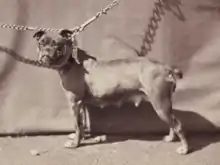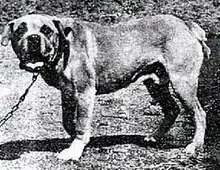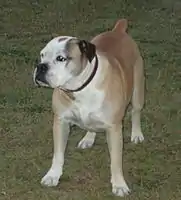Campeiro Bulldog
The Campeiro Bulldog (Portuguese: Buldogue campeiro, Portuguese pronunciation: [buwˈdɔg ˌkãˈpeiɾʊ]) is a dog breed developed in southern Brazil. It is believed to be a descendant of the Old English Bulldog introduced to Brazil by Europeans[1] and is closely related to the Serrano Bulldog.
| Campeiro Bulldog | |||||||||||||||||||||||||
|---|---|---|---|---|---|---|---|---|---|---|---|---|---|---|---|---|---|---|---|---|---|---|---|---|---|
_Campeiro.JPG.webp) | |||||||||||||||||||||||||
| Other names |
| ||||||||||||||||||||||||
| Common nicknames |
| ||||||||||||||||||||||||
| Origin | Brazil | ||||||||||||||||||||||||
| |||||||||||||||||||||||||
| |||||||||||||||||||||||||
| Dog (domestic dog) | |||||||||||||||||||||||||
Name
Campeiro, a Portuguese word meaning "fielder" or "related to fields", is widely used in the South Region of Brazil as a term for those who work in rural fields, especially those who take care of cattle and ride horses well. It is reflective of the field and its elements - rural, rustic, peasant, and so on.[2]
Origin
The Campeiro Bulldog gained prominence in the state of Mato Grosso do Sul, where it was used to herd cattle in slaughterhouses. During the 1970s, it faced extinction due to new sanitary regulations in slaughter houses and also due to the introduction of new breeds. Courtesy of the breeding programs launched by Ralf Bender, there has been a significant increase in number of members of this breed.[3]
There are multiple theories about the origin of the Campeiro Bulldog. The most widespread theory postulates the possibility that the Campeiro Bulldog originated from Old English Bulldogs (now extinct) that may have been brought to Brazil by European immigrants during the 19th or 20th century. Subsequently, these dogs were bred with the local dogs. A less popular theory suggests that the Campeiro Bulldog might actually be a remnant of the "Bulldog-type" variety of the Fila da Terceira.
First theory: Old English Bulldog

The Old English Bulldog was popular in most parts of Western Europe during the second half of the 19th century, to the point that in some states like the Vatican there is legislation regulating the transit of this dog breed on public roads.
At the same time, in Europe there was a surge in interest pertaining to the serious development, creation and conformation of several distinct breeds for the purpose of work or exhibition. As a result, several breeds were derived from the Old English Bulldog, such as the modern Bulldog and the Bull Terrier.
In Brazil, the European immigration (immigration of Germans, Italians, Polish, etc.) to the South Region, which was encouraged at various times during the early nineteenth and mid-twentieth centuries, resulted in an influx of many species of animals, including dogs, particularly several varieties of bulldogs, such as the Old English Bulldog.[4]
At the same time in Europe, standardization of most canine breeds was carried out mostly on the basis of appearance. However, dog breeds brought into the New World had to prove their worth by exhibiting their efficiency, physical excellence, and temperament in the daily course of work. Quest for development of these traits resulted in the creation of breeds that were significantly different from the ones that existed in Europe at the same time.
Thus, this particular variety of bulldog was preserved in the Brazilian lands, thanks to its ability to guard and work with cattle.
Second theory: Fila da Terceira

The Fila da Terceira was a Portuguese dog breed that originally lived on Terceira Island. These dogs were an outcome of the cross between the Spanish Mastiff, Portuguese Mastiff and the old Dogue de Bordeaux (which is different from the current breed). Later, during the 17th century, the Old English Bulldog was introduced, and it was the original "Bulldog-type" variety with reduced size, as compared to the "Mastiff-type" variety (without Bulldog insertion), bearing the characteristic crooked tail.
This dog was brought to Brazil during the Portuguese immigration as a result of the arrival of the Portuguese court in Brazilian lands. Its Mastiff-type variety (closest to the original form), on being crossed with Bloodhounds, may have resulted in the origin of the Fila Brasileiro, another Brazilian dog breed. It is believed that, later on, the Bulldog-type variety gave way to the Campeiro Bulldog, or at least contributed towards its formation.[5]
History
The Campeiro Bulldog helped its owners in handling cattle, but not as a herding dog. The dogs that excelled in working with wild cattle and swines were highly valued as much as those dogs that knew how to guard the cart and the horse of the tropeiros (the drivers of mules and horses' commissions that traveled between regions of Brazil during the 17th century). The breed has been exhibiting the functional features of its probable ancestor, namely the Old English Bulldog, which could hold swine through their ears to the slaughterhouse and could dominate a wild cow of up to 400 kg on its own.[6]
Its ability was widely employed in former slaughterhouses in the South Region of Brazil and in the region that now is the State of Mato Grosso do Sul. In these establishments, the dogs were used to subdue cattle and swine at the slaughtering. However, new law measures introduced by the sanitary surveillance prevented the use of dogs in these slaughterhouses. This event combined with the popularity of foreign breeds that arrived in Brazil at the 1970s and 1980s caused the devaluation of the Campeiro Bulldogs, which at the time were considered very common mutts, and the breed came close to extinction.
Breed's restoration
Even as a youth, the cynophile Ralf Schein Bender had fallen in love with the bravery of this dog breed that until then were referred to as Burdoga. His desire to own a dog of this kind made him realize the extreme shortage of the members of the breed. During the late 1970s, realizing that this dog was on the verge of extinction, Ralf Bender began to work towards rescuing these dogs. In 1977 he acquired a female and traveled all over the State of Rio Grande do Sul (RS) to gather the last specimens of the breed, and then began to breed them.[3] His work came to fruition in 2001 when CBKC (Brazilian Confederation of Cynophilia) officially granted recognition to the breed and conferred upon it the name Campeiro Bulldog.
Appearance

The Campeiro Bulldog is a medium-sized dog with a powerful physical complexion. It is very strong and slightly heavy dog for its size. It is a dog of broad constitution and an almost square muscular body. The breed has heavy bones and carries a typically broad head. It has a short muzzle (which should be 1/3 of the length of the skull), small and pendants ears inserted high on the head as far apart of each other as possible.[1] The tail is preferably short and crooked. The breed has a smooth short hair, and its coat could be in a variety of colors. Traditional coat color includes fawn, brown and brindle with white markings. There are dogs that are entirely white, but they must have pigmented mucous membranes and eyelids, to avoid problems while working.
Temperament
The Campiero Bulldog stands out for its loyalty towards its owner, ease of adaptation, and mainly for being affectionate towards children. Their rusticity and courage make them excellent guard dogs. This breed can be a bit jealous.
Suspicious of strangers and quiet, the Campiero Bulldog is known for not barking unnecessarily. These dogs need some daily exercise, if not directly involved in dealing with cattle or another type of work.
Health
The Campeiro Bulldog is a rustic breed. Although some specimens suffer from severe hip dysplasia, overall the condition affects only a few dogs. Presence of hip dysplasia was not noticed by many breeders and owners, and efforts to control this disease began (which may be genetic or due to lack of proper management of the pups) after the realization that the disease, which affects many breeds, was not uncommon or unusual in the Campiero Bulldog. Apart from this (in this breed, the hip dysplasia does not become a problem), there are no other diseases specific to the Campeiro Bulldog that affect the breed on a large scale. It is recommended to prevent external and internal parasites through vermifugation and combat infectious diseases through vaccination.
Exotic varieties
New breeders are mixing and inserting genes from other breeds to produce exotic varieties of Campeiro Bulldogs with different coat colors. As a result of these breeding programs involving the Olde English Bulldogge (OEB - an American dog breed developed in the 1970s), new Campeiro Bulldogs are emerging with new exotic coat colors that have never been common to the breed, such as dogs with blue, merle and tricolor coats.[7][8]
Bibliography
- (in Portuguese) CÃES & CIA, Brasil: Editora Forix, 2001, mensal, Edição nº 267, ISSN 1413-3040, reportagem Brasil:novas raças avançam.
- (in Portuguese) CÃES & CIA, Brasil: Editora Forix, 2001, mensal, Edição nº 269, ISSN 1413-3040, reportagem Buldogues, agora são 7!
- (in Portuguese) CÃES & CIA, Brasil: Editora Forix, 2002, mensal, Edição nº 272, ISSN 1413-3040, reportagem Raça Canina Brasileira - Buldogue Campeiro Ganha direito a Pedigree.
- (in Portuguese) CÃES & CIA, Brasil: Editora Forix, 2003, mensal, Edição nº 293, ISSN 1413-3040, reportagem Novas Raças Brasileiras.
- (in Portuguese) CÃES & CIA, Brasil: Editora Forix, 2005, mensal, Edição nº 319, ISSN 1413-3040, reportagem Cães fora de série Buldogue Campeiro.
- (in Portuguese) ALMANAQUE CÃES & RAÇAS 2009, Brasil: Editora On Line, 2009, annual, reportagem Made In Brazil.
- (in Portuguese) CÃES & CIA, Brasil: Editora Forix, 2010, mensal, Edição nº 371, ISSN 1413-3040, reportagem Super Guia do Brasileiríssimo.
- (in Portuguese) CÃES & CIA, Brasil: Editora Forix, 2010, mensal, Edição nº 374, ISSN 1413-3040, reportagem Todos os Buldogues! Americano, Campeiro, Francês, Inglês, Olde English e Serrano.
References
- Campeiro Bulldog breed standard - CBKC (in Portuguese)
- Creative Dictionary: Campeiro (in Portuguese)
- G1 - Dog breeder says to have traveled the RS to save the Campeiro Bulldog of the extinction (in Portuguese)
- The Bully Breeds by David Harris
- Terceira Mastiff and relatives breeds (in Portuguese)
- * (in Portuguese) CÃES & CIA magazine, Brazil: Editora Forix, 2005, mensal, Edição nº 319, ISSN 1413-3040, reportagem Cães fora de série Buldogue Campeiro.
- Exotic Colors in Campeiro Bulldogs: Blue Coat. (in Portuguese)
- Coats: Exotic coats - history Archived 2018-08-25 at the Wayback Machine (in Portuguese)
External links
| Wikimedia Commons has media related to Campeiro Bulldog. |
- Exotic colors and insertions in the Campeiro Bulldog by Ederson Silva (in Portuguese)
- Interview with Ralf Bender, Núbia Nonnemacher, Paranhana On-line. Access April, 2010. (in Portuguese)
- Cãodomínio kennel (in Portuguese)
- Campeiro Bulldog breed standard - CBKC (in Portuguese)
- Breeds Guide - Buldogue Campeiro (in Portuguese)
- French Bulldog or Teacup French Bulldog